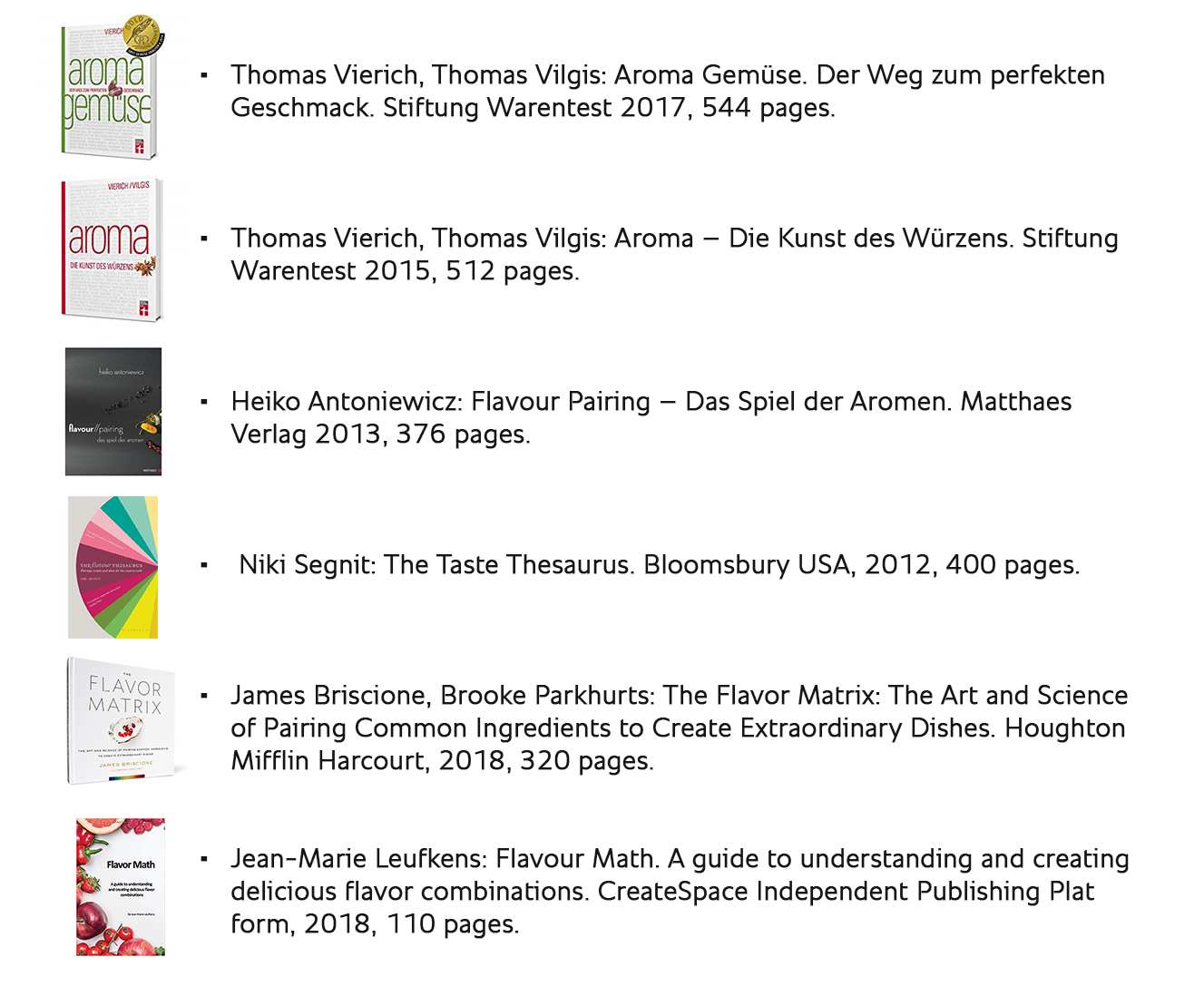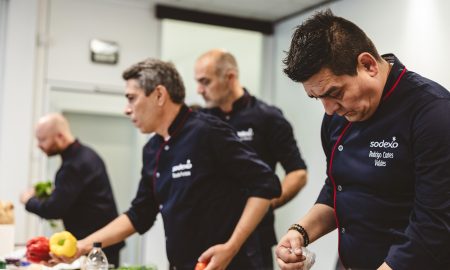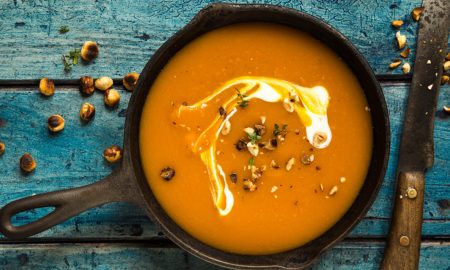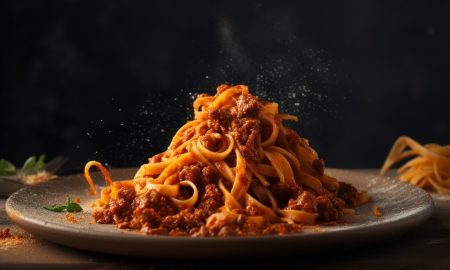Question Everything.
He’s somewhere between Peter Pan and a wacky professor, the wizard-like ringmaster of his own culinary circus, and the dining experiences he creates are nothing short of magical: floating desserts presented atop silk pillows, a doll house filled with sweet treats, oyster foam served along with a seashell containing headphones that play ocean sounds. Heston Blumenthal, the world’s most eccentric three-star chef, is a culinary scientist and creative genius whose motto is “Question everything.” He goes about it with the help of physicists and chemists from around the world, as well as perfume-makers and even psychologists.
Tastes great. But why?
Though his restaurant, The Fat Duck, was at one time probably the world’s most famous restaurant, there was one question Heston Blumenthal still couldn’t answer: Why do some ingredients taste good with others? He was trying to figure out what would go well with caviar, and on a whim, he reached for a piece of white Valrhona chocolate. He crammed them both into his mouth, letting the sweetness of the chocolate mingle with the salty caviar, and a lightbulb went on. He’d put the two ingredients together by chance, but the combination itself was exquisite, and the resulting dish soon became one of the best-known items on the Fat Duck’s menu. That wasn’t the only pairing Blumenthal stumbled upon by chance—he also discovered the magic of dark chocolate with blue cheese, for example.
Liver and jasmine? It’s science time!
Even so, having discovered that the ingredients went beautifully together didn’t get Blumenthal any closer to understanding why. He turned to perfume-maker and food scientist François Benzi (who’d become fascinated by Blumenthal’s cuisine after having an “a-ha” moment of his own, when he sniffed a bunch of jasmine flowers and detected a faint note of… liver?) to help him investigate the question from a scientific perspective. Benzi performed lab analyses of the white chocolate and the caviar, and made a surprising discovery: as different as the two foods are, they both have the aminoxide trimethyl amine as their base aroma. Blumenthal and Benzi delved deeper, uncovering even more unusual pairings like salmon with licorice, rose with chicken, and vanilla with tomatoes. Eventually, they came up with an axiom: ingredients go well together when they have the same primary aroma components.
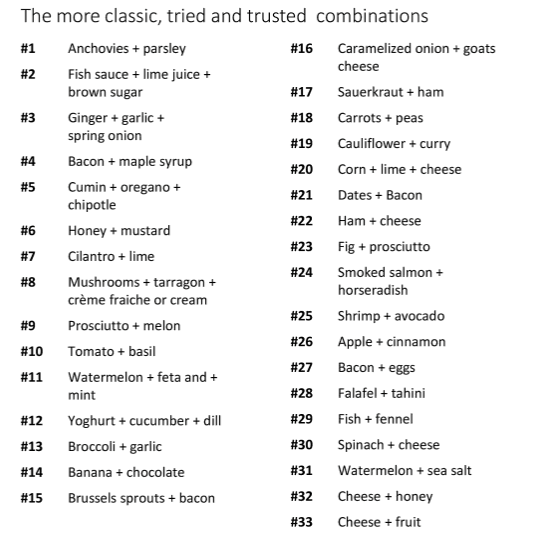
Classic, tried and trusted food pairing combinations | Source: Flavour Math
Molecular matchmaking: Tinder for aromas
Blumenthal and Benzi made their big discovery back in 1992; today, it’s known as “food pairing”, and it’s a practically inexhaustible trove of new ideas. There are more than 10,000 primary aromas in all, allowing millions of possible combinations. Strawberries alone have 400 aromas. Nowadays, you can find countless food blogs and cookbooks dedicated to food pairing, and some of the world’s most renowned researchers are looking into the science behind molecular matchmaking. Physics professor Thomas Vilgis, who normally researches polymers at the Max Planck Institute, purees foods and analyzes them through gas chromatography to identify their key aromas. Cucumber and salmon? Bacon and cheese? Melted butter on fresh asparagus? The fact that we like to eat certain foods together isn’t just a matter of culinary tradition, it’s actually based on chemistry—on the overlap between certain aroma molecules. Vilgis isn’t just looking into the molecules that ingredients have in common, though. He’s also studying contrasting aroma profiles and how they create more exciting taste experiences. The “opposites attract” phenomenon is the reason chili and chocolate are a match made in heaven; it also makes caramel cream go great with soy sauce, and explains why mint gives mustard sauce an unexpected kick.
Digital subscriptions to flavor family trees?
Belgian agricultural engineer Bernard Lahousse researches key aromas and then brings them into his test kitchen, where chefs turn his discoveries into totally new creations. For example, he works with The Chocolate Line’s avant-garde chocolatier, Dominique Persoone, who fills his delicious truffles with ganaches spiked with bacon, soy sauce, absinthe, and onions, just to name a few. Crazy? Nope, science. Molecular chemistry, specifically. At any rate, his truffles are fantastic—there’s always a line outside Persoone’s door. Customers doing blind taste tests can’t identify what exactly they’re eating… for some reason “blue cheese” just doesn’t come to mind as a possible truffle flavor. All they know is that, whatever it is, it’s delicious. Lahousse systematizes the different aromas into databases and flavor family trees, and then offers them to chefs and bartenders all over the world to help them create new combinations. His website, foodpairing.com, offers food scientists, sommeliers, and chefs access to his algorithms for a small monthly fee. Now, people all over the world are combining pork rinds with cherry powder, adding bacon to their ice cream, and smoking Earl Grey tea—food pairing is one of the most exciting fields of culinary experimentation out there.
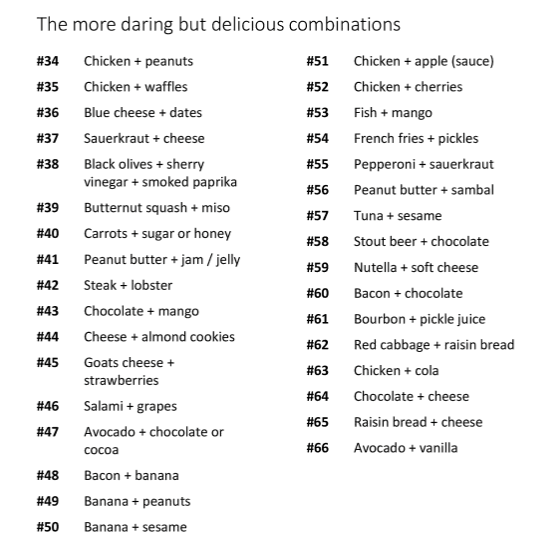
Daring but delicious food pairing combinations | Source: Flavour Math
Watson and strawberry ketchup
Chicken, mushrooms, strawberries… Do those go together? James Briscione, Director of Culinary Development at the New York Institute of Culinary Education, asked himself that question back in 2012. IBM had asked him to look into the supercomputer Watson and the potential it offered in terms of a food-pairing database. Briscoine spent four years working on the database and researching flavor chemistry, and recently published his results in a book entitled The Flavor Matrix. He’d never have discovered some of his favorite combinations without Watson’s help: blueberries and horseradish, for example, or tomatoes and coconut. The most interesting thing about food pairing is that, even though it has its roots in molecular gastronomy, it’s not elitist at all. Quite the opposite, in fact—you can use it anywhere, anytime, with simple ingredients and recipes, and diners can enjoy it whether or not they have “adventurous” palates. Even children like cucumber lemonade and basil ice cream, and many people are pleasantly surprised by grilled pineapple, whose roasted umami notes go great with the tart-sweet flavor of the fruit. And salt with caramel? Perfect! So what about the chicken-mushroom-strawberry combination that got Briscoine started on this idea in the first place? According to Watson, it’s a great match. Briscoine’s tongue and bulbus olfactorius came to the same conclusion; he suggests a chicken burger with sauteed portobello mushrooms and strawberry ketchup. Not all that exotic, really. Of course, many perfect food pairings have existed since time immemorial, with or without Watson and its databases. Pears, beans, and bacon, for example, is a North German classic combination, a near-perfect harmony of similarities and contrasts that no algorithm in the world could improve upon. Even a culinary magician like Heston Blumenthal would have to tip his hat to that.
Further reading:
